DODGE DART 2014 PF / 1.G Manual PDF
Manufacturer: DODGE, Model Year: 2014, Model line: DART, Model: DODGE DART 2014 PF / 1.GPages: 656, PDF Size: 4.73 MB
Page 71 of 656
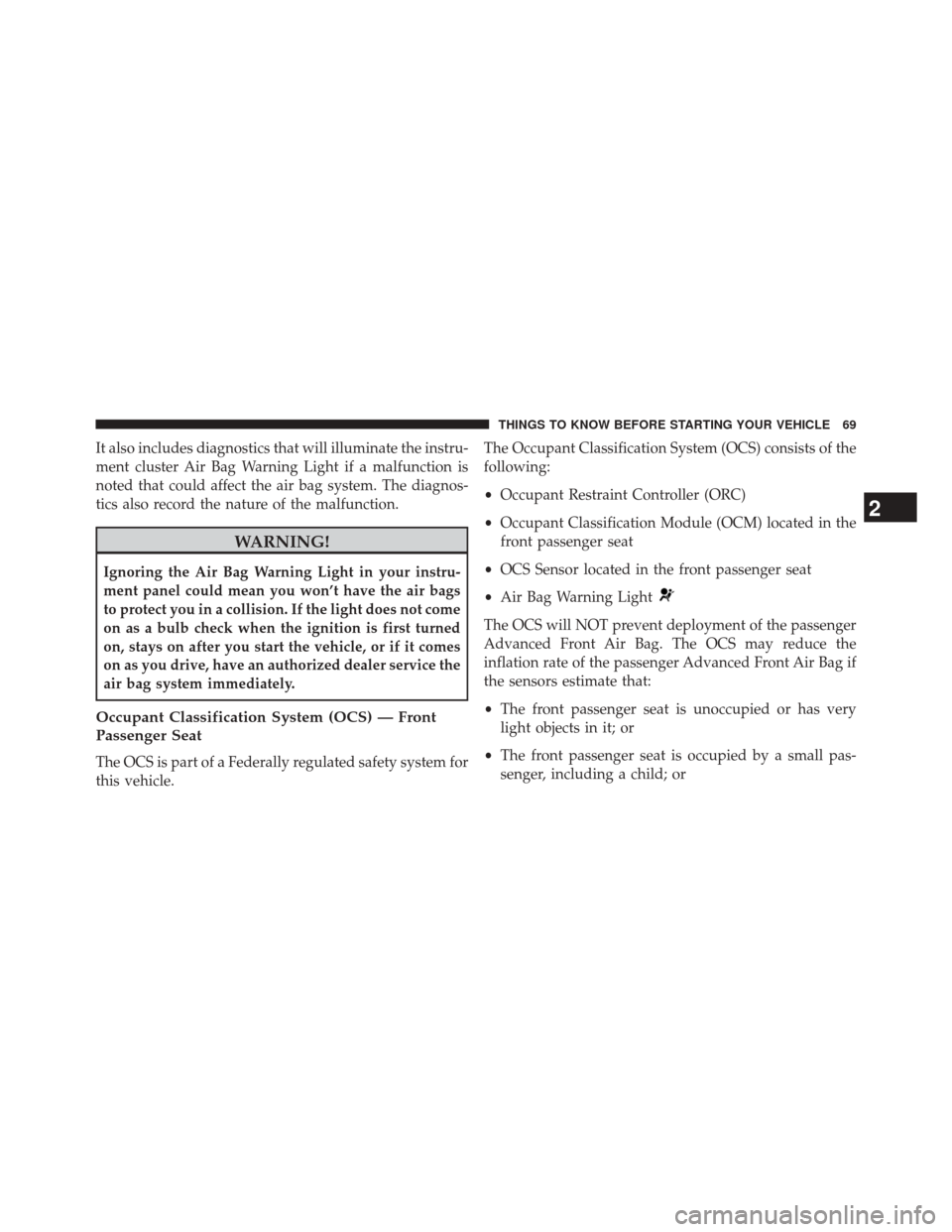
It also includes diagnostics that will illuminate the instru-
ment cluster Air Bag Warning Light if a malfunction is
noted that could affect the air bag system. The diagnos-
tics also record the nature of the malfunction.
WARNING!
Ignoring the Air Bag Warning Light in your instru-
ment panel could mean you won’t have the air bags
to protect you in a collision. If the light does not come
on as a bulb check when the ignition is first turned
on, stays on after you start the vehicle, or if it comes
on as you drive, have an authorized dealer service the
air bag system immediately.
Occupant Classification System (OCS) — Front
Passenger Seat
The OCS is part of a Federally regulated safety system for
this vehicle.The Occupant Classification System (OCS) consists of the
following:
•
Occupant Restraint Controller (ORC)
• Occupant Classification Module (OCM) located in the
front passenger seat
• OCS Sensor located in the front passenger seat
• Air Bag Warning Light
The OCS will NOT prevent deployment of the passenger
Advanced Front Air Bag. The OCS may reduce the
inflation rate of the passenger Advanced Front Air Bag if
the sensors estimate that:
•The front passenger seat is unoccupied or has very
light objects in it; or
• The front passenger seat is occupied by a small pas-
senger, including a child; or
2
THINGS TO KNOW BEFORE STARTING YOUR VEHICLE 69
Page 72 of 656
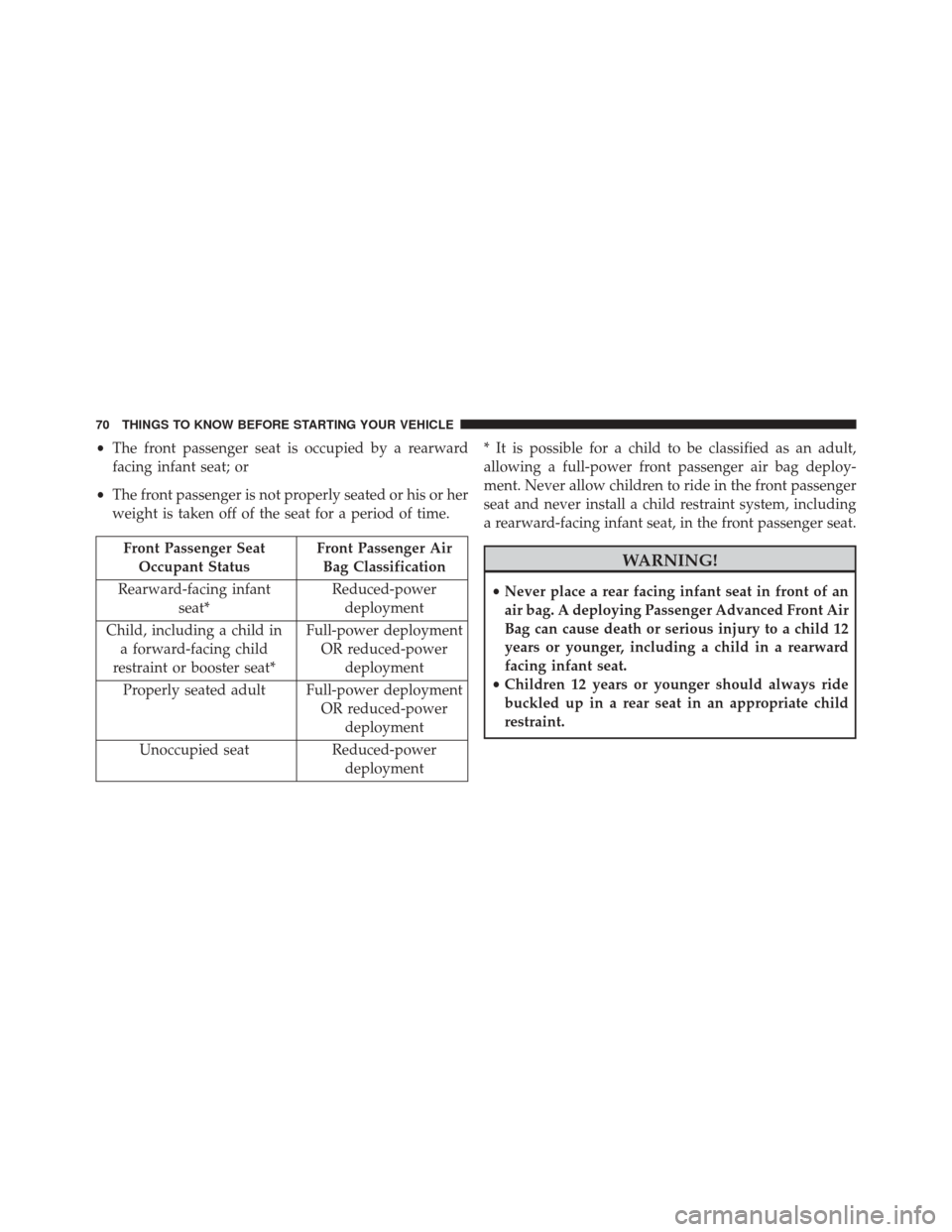
•The front passenger seat is occupied by a rearward
facing infant seat; or
• The front passenger is not properly seated or his or her
weight is taken off of the seat for a period of time.
Front Passenger Seat
Occupant Status Front Passenger Air
Bag Classification
Rearward-facing infant seat* Reduced-power
deployment
Child, including a child in a forward-facing child
restraint or booster seat* Full-power deployment
OR reduced-power deployment
Properly seated adult Full-power deployment OR reduced-powerdeployment
Unoccupied seat Reduced-power deployment* It is possible for a child to be classified as an adult,
allowing a full-power front passenger air bag deploy-
ment. Never allow children to ride in the front passenger
seat and never install a child restraint system, including
a rearward-facing infant seat, in the front passenger seat.WARNING!
•
Never place a rear facing infant seat in front of an
air bag. A deploying Passenger Advanced Front Air
Bag can cause death or serious injury to a child 12
years or younger, including a child in a rearward
facing infant seat.
• Children 12 years or younger should always ride
buckled up in a rear seat in an appropriate child
restraint.
70 THINGS TO KNOW BEFORE STARTING YOUR VEHICLE
Page 73 of 656
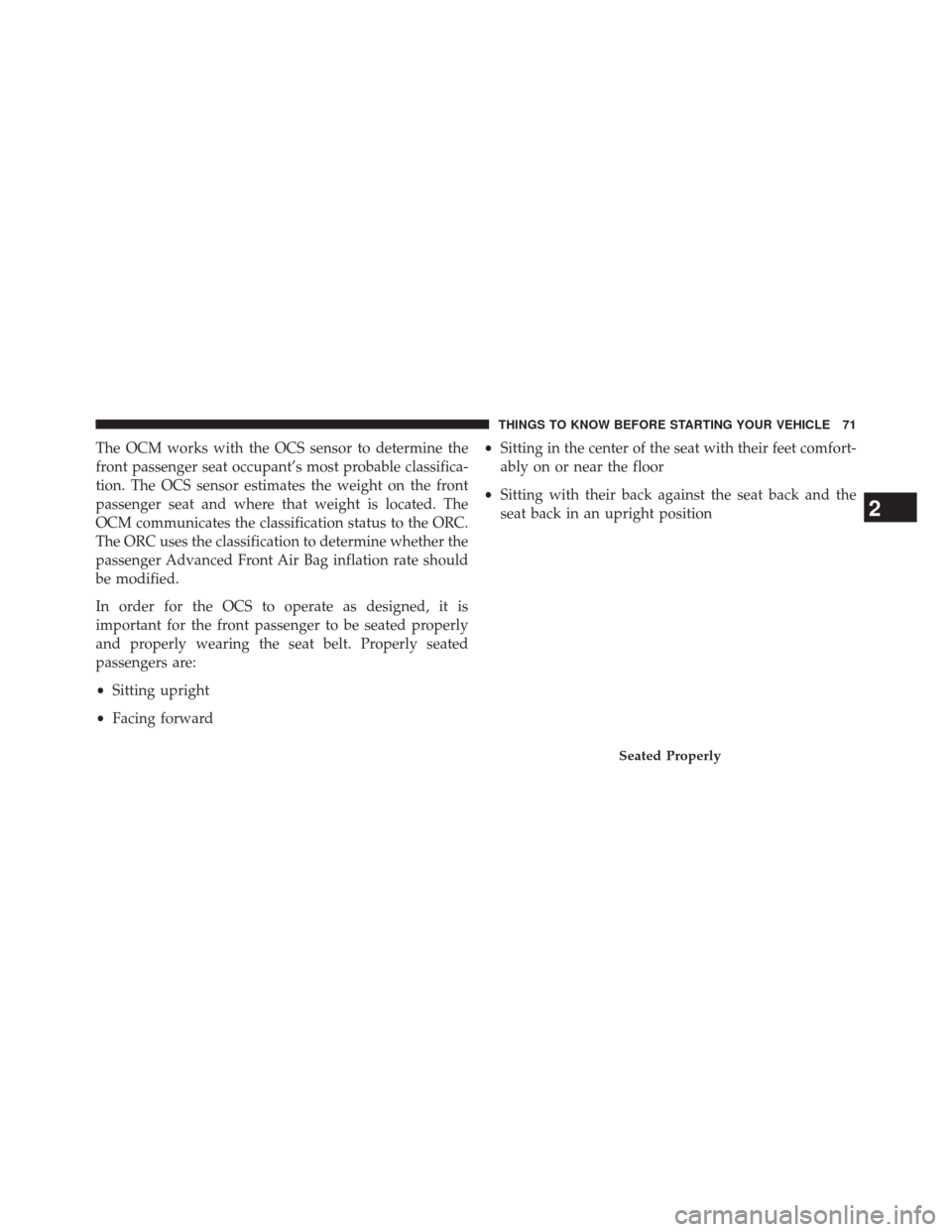
The OCM works with the OCS sensor to determine the
front passenger seat occupant’s most probable classifica-
tion. The OCS sensor estimates the weight on the front
passenger seat and where that weight is located. The
OCM communicates the classification status to the ORC.
The ORC uses the classification to determine whether the
passenger Advanced Front Air Bag inflation rate should
be modified.
In order for the OCS to operate as designed, it is
important for the front passenger to be seated properly
and properly wearing the seat belt. Properly seated
passengers are:
•Sitting upright
• Facing forward •
Sitting in the center of the seat with their feet comfort-
ably on or near the floor
• Sitting with their back against the seat back and the
seat back in an upright position
Seated Properly
2
THINGS TO KNOW BEFORE STARTING YOUR VEHICLE 71
Page 74 of 656
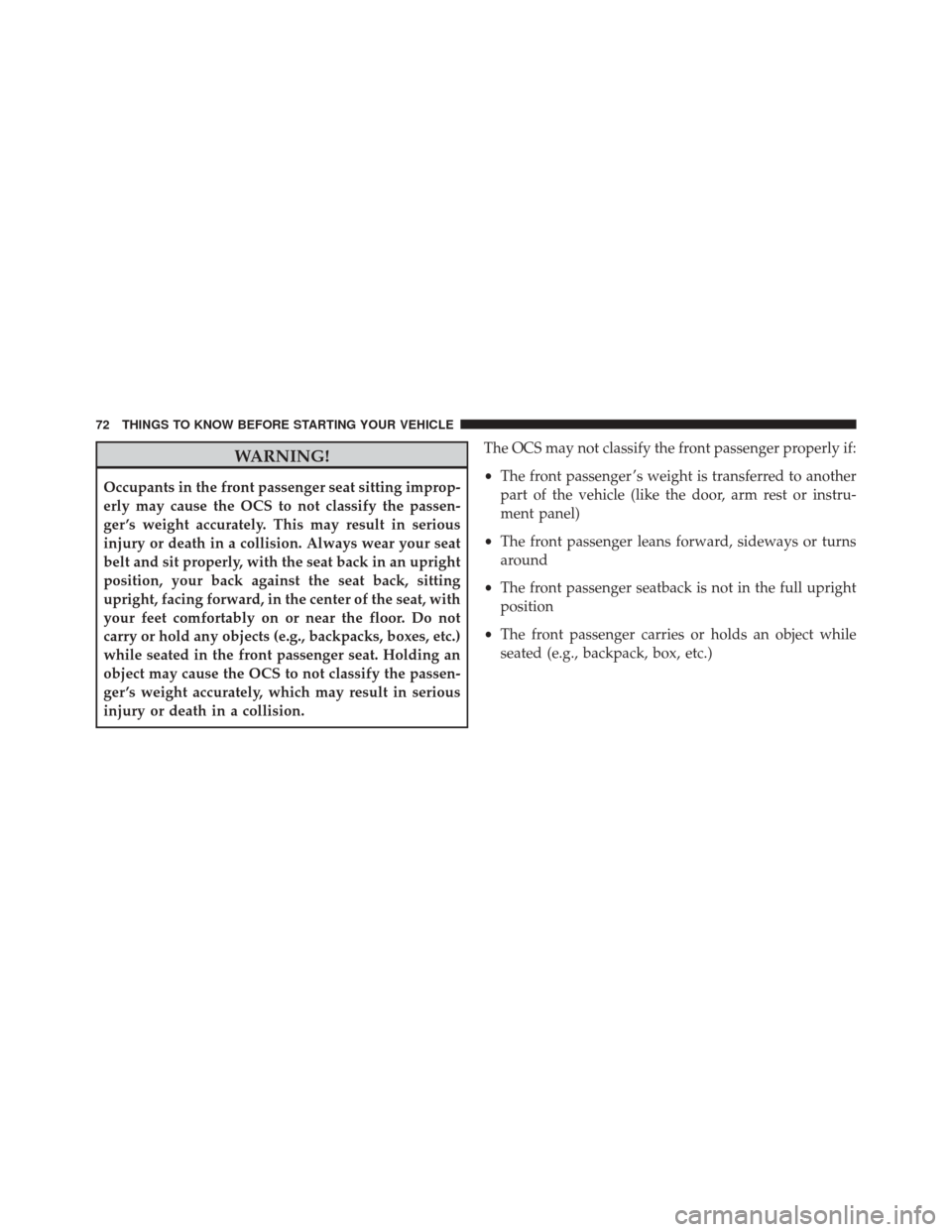
WARNING!
Occupants in the front passenger seat sitting improp-
erly may cause the OCS to not classify the passen-
ger ’s weight accurately. This may result in serious
injury or death in a collision. Always wear your seat
belt and sit properly, with the seat back in an upright
position, your back against the seat back, sitting
upright, facing forward, in the center of the seat, with
your feet comfortably on or near the floor. Do not
carry or hold any objects (e.g., backpacks, boxes, etc.)
while seated in the front passenger seat. Holding an
object may cause the OCS to not classify the passen-
ger ’s weight accurately, which may result in serious
injury or death in a collision.The OCS may not classify the front passenger properly if:
•
The front passenger ’s weight is transferred to another
part of the vehicle (like the door, arm rest or instru-
ment panel)
• The front passenger leans forward, sideways or turns
around
• The front passenger seatback is not in the full upright
position
• The front passenger carries or holds an object while
seated (e.g., backpack, box, etc.)
72 THINGS TO KNOW BEFORE STARTING YOUR VEHICLE
Page 75 of 656

Not Seated ProperlyNot Seated Properly
2
THINGS TO KNOW BEFORE STARTING YOUR VEHICLE 73
Page 76 of 656

Not Seated ProperlyNot Seated Properly
74 THINGS TO KNOW BEFORE STARTING YOUR VEHICLE
Page 77 of 656
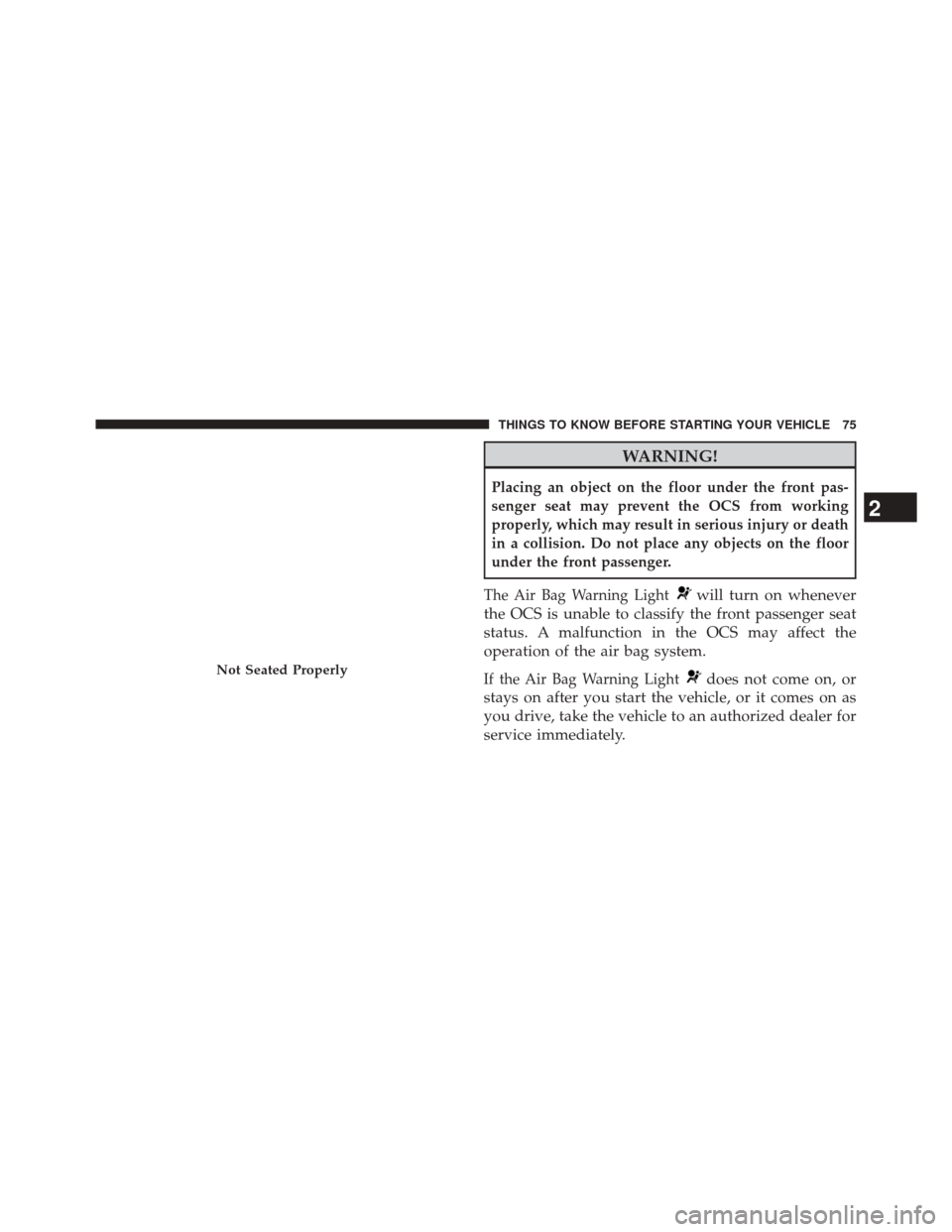
WARNING!
Placing an object on the floor under the front pas-
senger seat may prevent the OCS from working
properly, which may result in serious injury or death
in a collision. Do not place any objects on the floor
under the front passenger.
The Air Bag Warning Light
will turn on whenever
the OCS is unable to classify the front passenger seat
status. A malfunction in the OCS may affect the
operation of the air bag system.
If the Air Bag Warning Lightdoes not come on, or
stays on after you start the vehicle, or it comes on as
you drive, take the vehicle to an authorized dealer for
service immediately.Not Seated Properly
2
THINGS TO KNOW BEFORE STARTING YOUR VEHICLE 75
Page 78 of 656
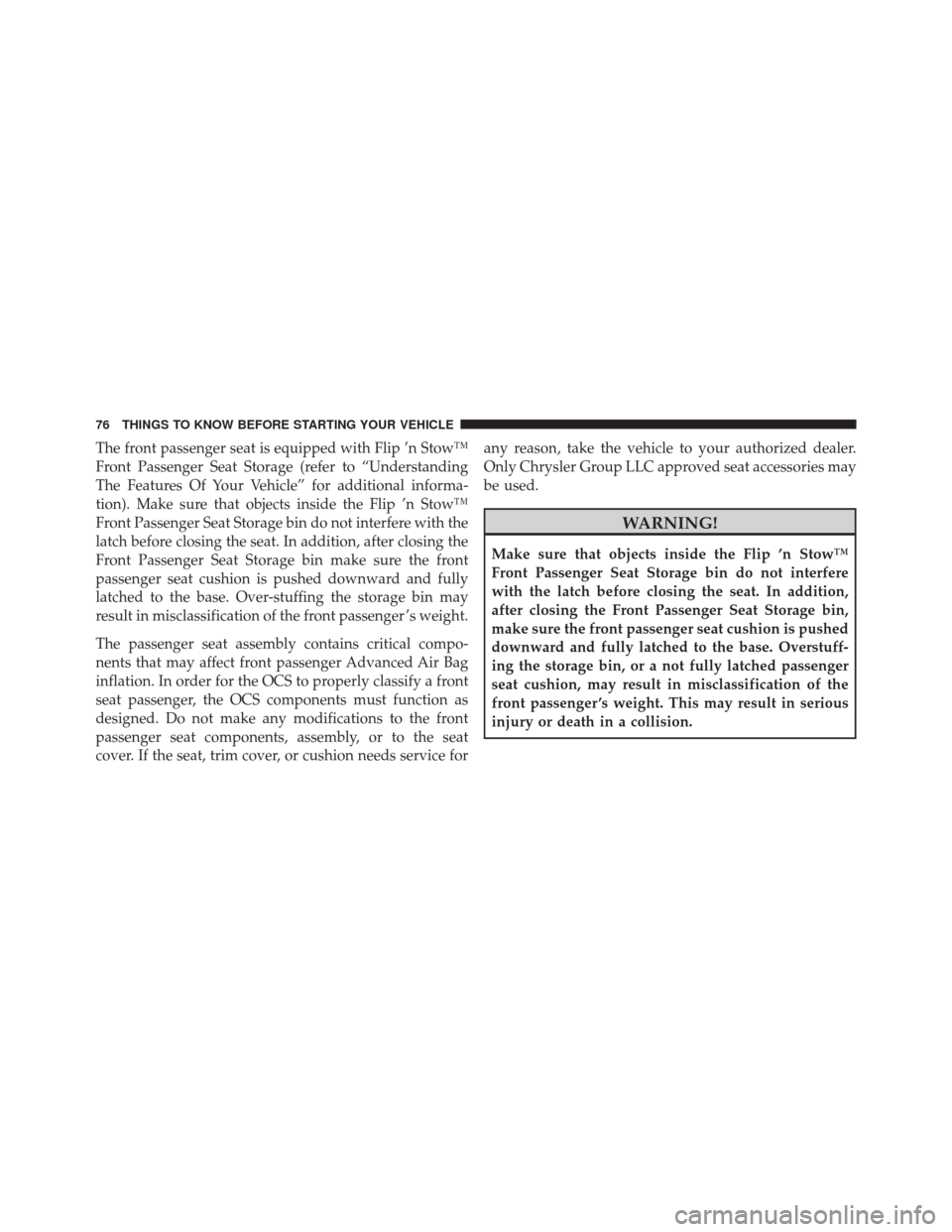
The front passenger seat is equipped with Flip ’n Stow™
Front Passenger Seat Storage (refer to “Understanding
The Features Of Your Vehicle” for additional informa-
tion). Make sure that objects inside the Flip ’n Stow™
Front Passenger Seat Storage bin do not interfere with the
latch before closing the seat. In addition, after closing the
Front Passenger Seat Storage bin make sure the front
passenger seat cushion is pushed downward and fully
latched to the base. Over-stuffing the storage bin may
result in misclassification of the front passenger ’s weight.
The passenger seat assembly contains critical compo-
nents that may affect front passenger Advanced Air Bag
inflation. In order for the OCS to properly classify a front
seat passenger, the OCS components must function as
designed. Do not make any modifications to the front
passenger seat components, assembly, or to the seat
cover. If the seat, trim cover, or cushion needs service forany reason, take the vehicle to your authorized dealer.
Only Chrysler Group LLC approved seat accessories may
be used.
WARNING!
Make sure that objects inside the Flip ’n Stow™
Front Passenger Seat Storage bin do not interfere
with the latch before closing the seat. In addition,
after closing the Front Passenger Seat Storage bin,
make sure the front passenger seat cushion is pushed
downward and fully latched to the base. Overstuff-
ing the storage bin, or a not fully latched passenger
seat cushion, may result in misclassification of the
front passenger ’s weight. This may result in serious
injury or death in a collision.
76 THINGS TO KNOW BEFORE STARTING YOUR VEHICLE
Page 79 of 656
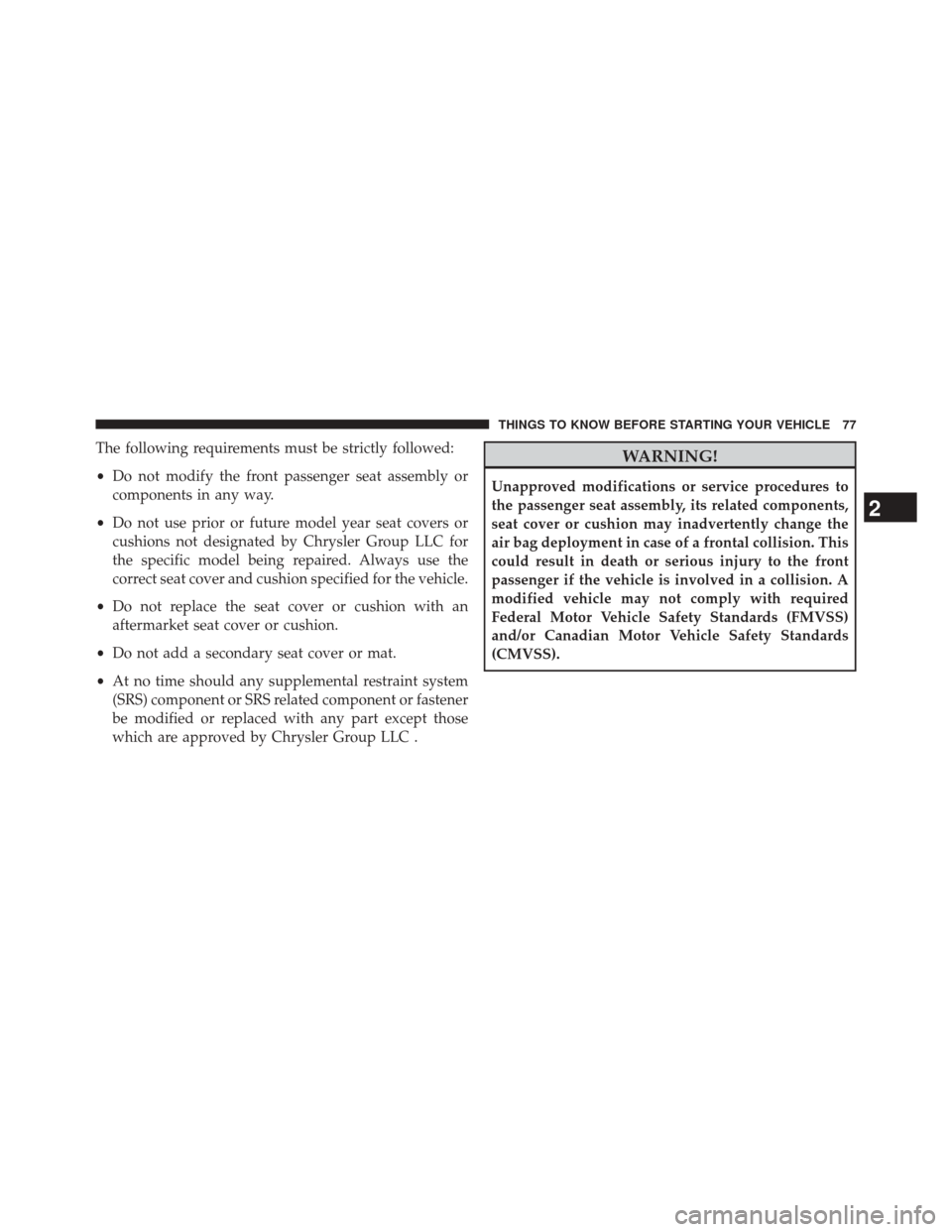
The following requirements must be strictly followed:
•Do not modify the front passenger seat assembly or
components in any way.
• Do not use prior or future model year seat covers or
cushions not designated by Chrysler Group LLC for
the specific model being repaired. Always use the
correct seat cover and cushion specified for the vehicle.
• Do not replace the seat cover or cushion with an
aftermarket seat cover or cushion.
• Do not add a secondary seat cover or mat.
• At no time should any supplemental restraint system
(SRS) component or SRS related component or fastener
be modified or replaced with any part except those
which are approved by Chrysler Group LLC .WARNING!
Unapproved modifications or service procedures to
the passenger seat assembly, its related components,
seat cover or cushion may inadvertently change the
air bag deployment in case of a frontal collision. This
could result in death or serious injury to the front
passenger if the vehicle is involved in a collision. A
modified vehicle may not comply with required
Federal Motor Vehicle Safety Standards (FMVSS)
and/or Canadian Motor Vehicle Safety Standards
(CMVSS).
2
THINGS TO KNOW BEFORE STARTING YOUR VEHICLE 77
Page 80 of 656
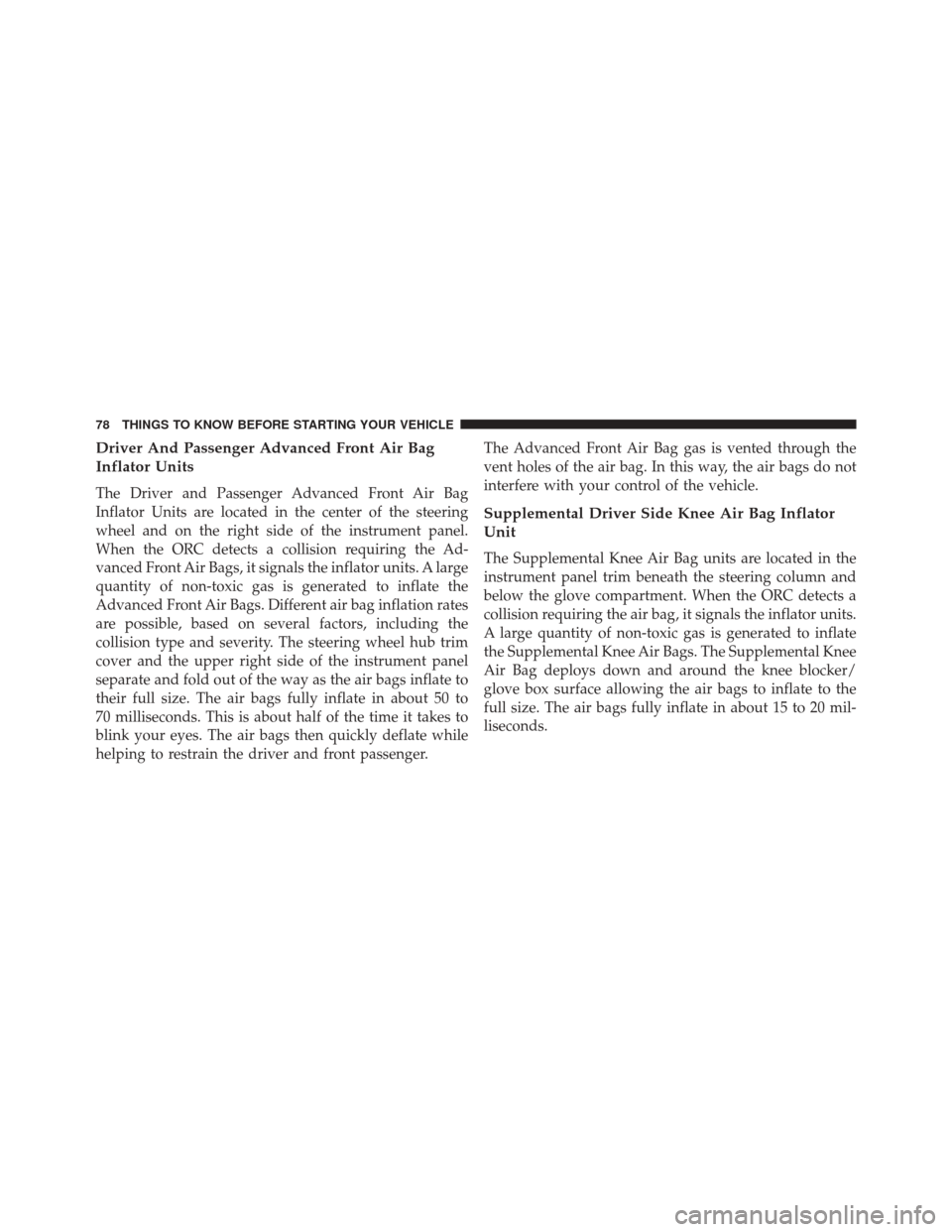
Driver And Passenger Advanced Front Air Bag
Inflator Units
The Driver and Passenger Advanced Front Air Bag
Inflator Units are located in the center of the steering
wheel and on the right side of the instrument panel.
When the ORC detects a collision requiring the Ad-
vanced Front Air Bags, it signals the inflator units. A large
quantity of non-toxic gas is generated to inflate the
Advanced Front Air Bags. Different air bag inflation rates
are possible, based on several factors, including the
collision type and severity. The steering wheel hub trim
cover and the upper right side of the instrument panel
separate and fold out of the way as the air bags inflate to
their full size. The air bags fully inflate in about 50 to
70 milliseconds. This is about half of the time it takes to
blink your eyes. The air bags then quickly deflate while
helping to restrain the driver and front passenger.The Advanced Front Air Bag gas is vented through the
vent holes of the air bag. In this way, the air bags do not
interfere with your control of the vehicle.
Supplemental Driver Side Knee Air Bag Inflator
Unit
The Supplemental Knee Air Bag units are located in the
instrument panel trim beneath the steering column and
below the glove compartment. When the ORC detects a
collision requiring the air bag, it signals the inflator units.
A large quantity of non-toxic gas is generated to inflate
the Supplemental Knee Air Bags. The Supplemental Knee
Air Bag deploys down and around the knee blocker/
glove box surface allowing the air bags to inflate to the
full size. The air bags fully inflate in about 15 to 20 mil-
liseconds.
78 THINGS TO KNOW BEFORE STARTING YOUR VEHICLE